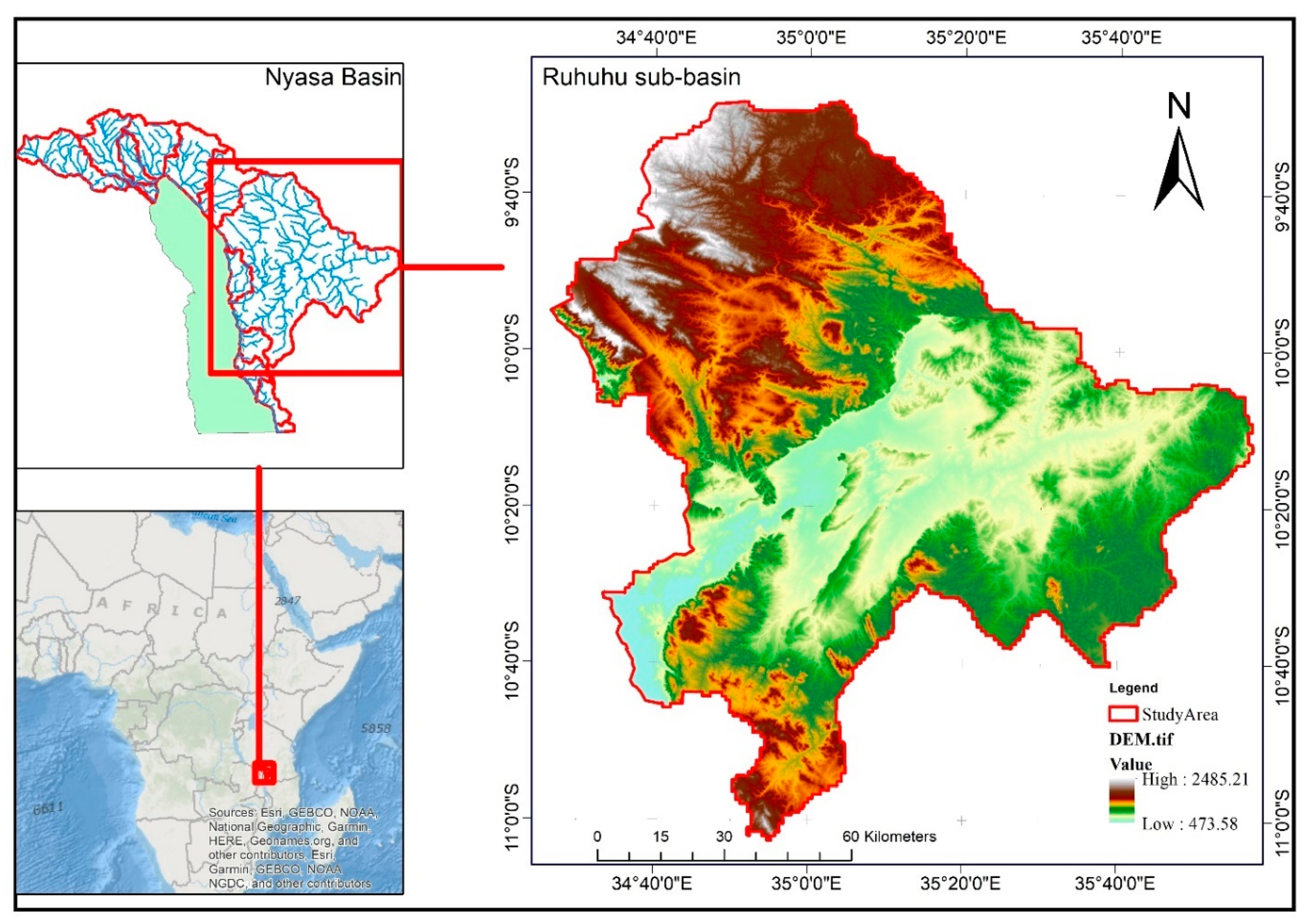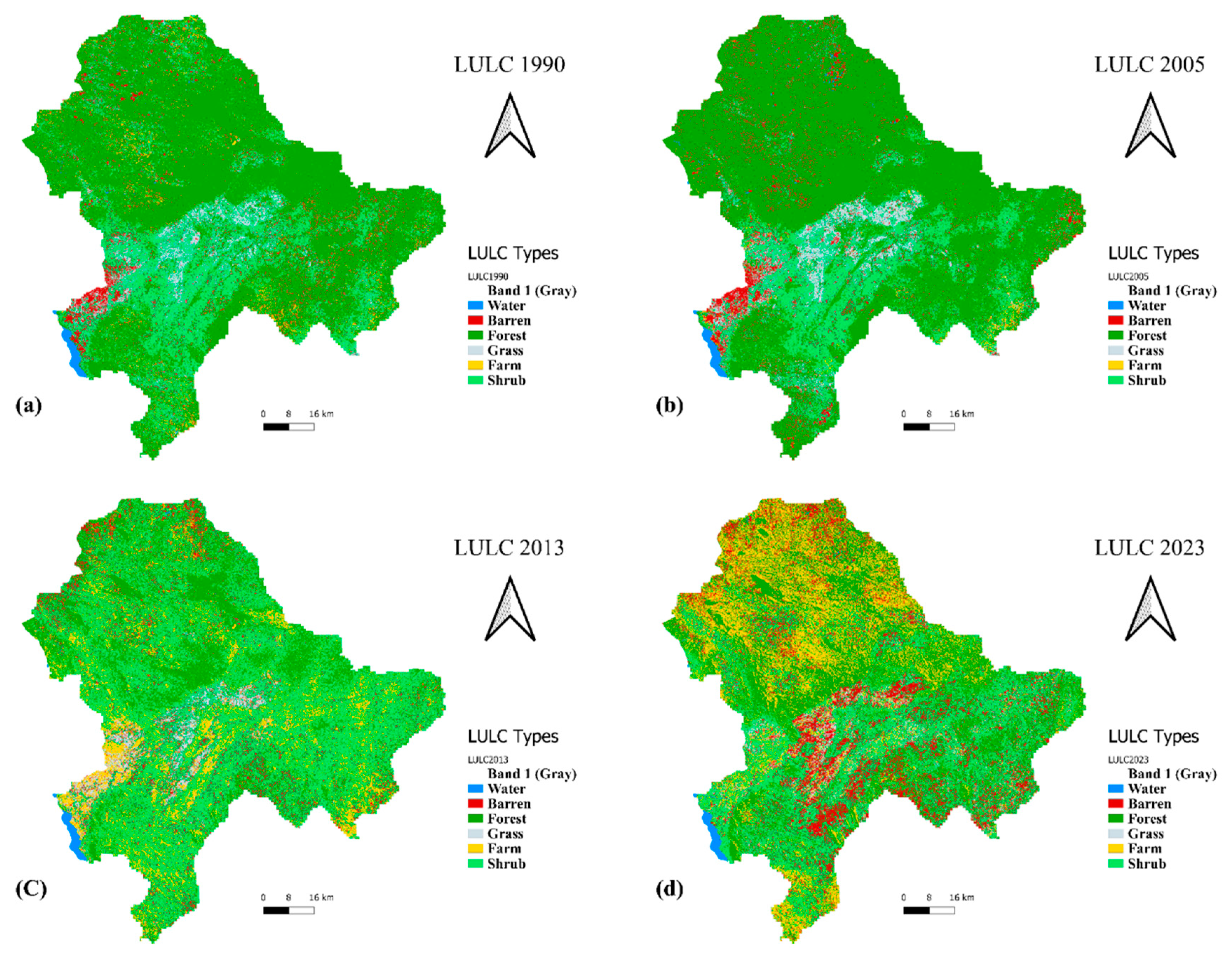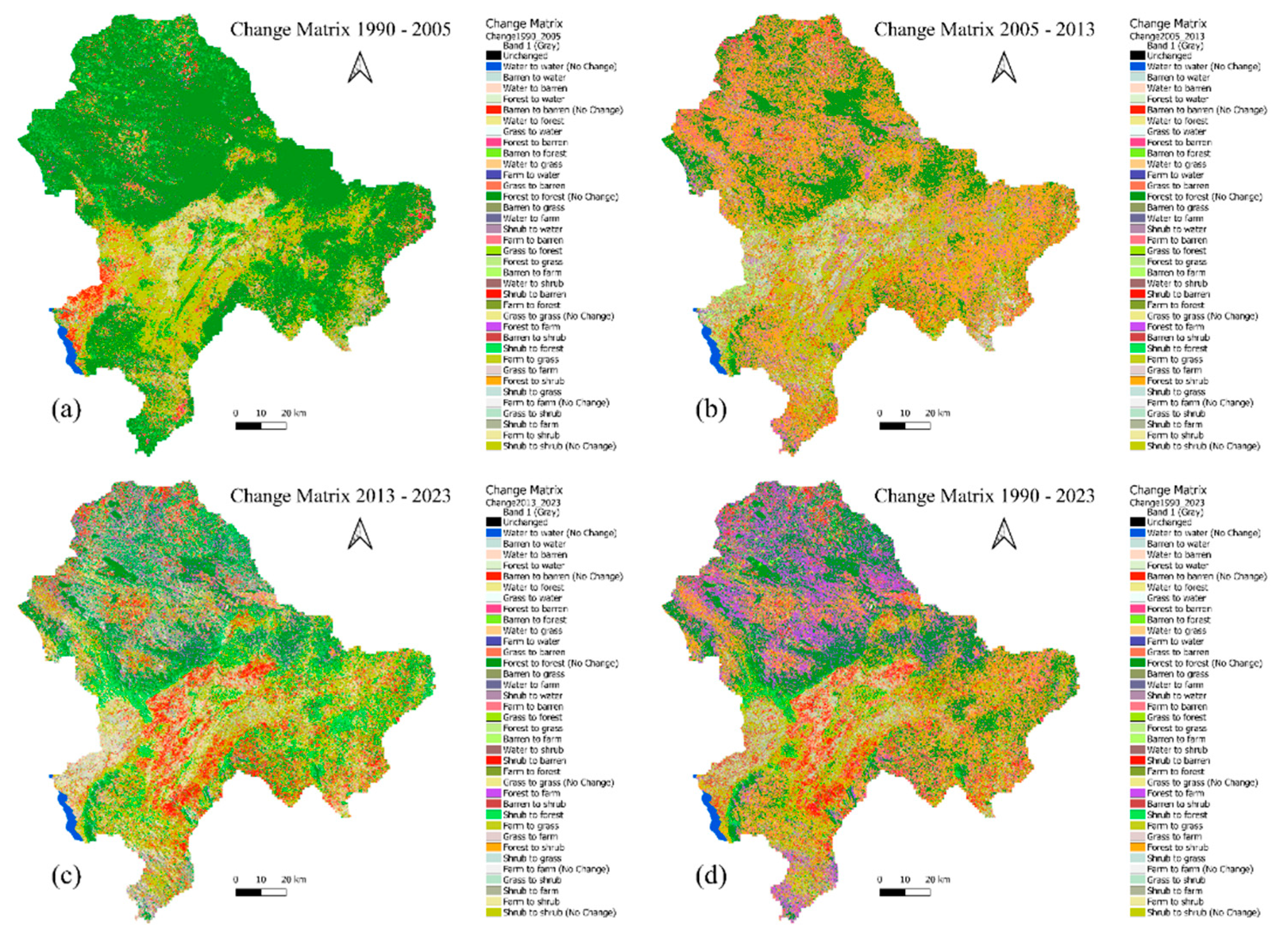Submitted:
14 July 2024
Posted:
15 July 2024
You are already at the latest version
Abstract
Keywords:
Introduction
Methods
Location of Study Area
Data Acquisition and Preprocessing
Land Use and Land Cover Classification
Ground Truthing and Validation
Results
Accuracy Assessment
| Accuracy Assessment | ||
|---|---|---|
| Year | OA | KC |
| 1990 | 0.967 | 0.956 |
| 2005 | 0.987 | 0.982 |
| 2013 | 0.983 | 0.976 |
| 2023 | 0.909 | 0.885 |
Land Use and Land Cover (1990-2023)
LULC Change Matrix (2013-2023)
Discussion
Conclusion and Recommendations
- Promote sustainable agricultural practices: Encourage the adoption of agroforestry, conservation agriculture, and other sustainable farming techniques that minimise environmental impacts and maintain soil fertility.
- Implementing reforestation and afforestation programs: Prioritise the restoration of degraded forest areas and establish new forest plantations to enhance carbon sequestration, biodiversity, and water regulation.
- Enforce regulations on land use and mining activities: Strengthen enforcement of existing laws and regulations to prevent unsustainable land use practices, including deforestation, overgrazing, and uncontrolled mining.
- Invest soil conservation measures: Promote terracing, contour farming, and other soil conservation practices to reduce soil erosion and maintain soil productivity.
- Establish a comprehensive monitoring and evaluation system: Develop a robust system for monitoring LULC changes, water quality, and other environmental indicators to assess the effectiveness of interventions and inform adaptive management strategies.
- Enhance community engagement and awareness: Engage local communities in land-use planning and decision-making processes and raise awareness about the importance of sustainable land management practices for their livelihoods and the environment.
Author Contributions
Funding
Data Availability Statement
Acknowledgements
Conflicts of Interest
References
- Akbar, T. A., Hassan, Q. K., Ishaq, S., Batool, M., Butt, H. J., & Jabbar, H. (2019). Investigative spatial distribution and modelling of existing and future urban land changes and their impact on urbanisation and the economy. Remote Sensing, 11(2). [CrossRef]
- Blicharska, M., Angelstam, P., Giessen, L., Hilszczański, J., Hermanowicz, E., Holeksa, J., Jacobsen, J. B., Jaroszewicz, B., Konczal, A., Konieczny, A., Mikusiński, G., Mirek, Z., Mohren, F., Muys, B., Niedziałkowski, K., Sotirov, M., Stereńczak, K., Szwagrzyk, J., Winder, G. M., … Winkel, G. (2020). Between biodiversity conservation and sustainable forest management: A multidisciplinary assessment of the emblematic Białowieża Forest case. Biological Conservation, 248(April), 108614. [CrossRef]
- Chavula, G. M. S., M’balaka, M. S., Gondwe, E., Ngochera, M., Halafo, J. S., Shechonge, A. H., Gabagambi, N. P., Mbonde, A. S., Banda, D., Muyumbana, N., Lawrence, T. J., Ajode, M. Z., Smith, S., Jonasse, C., Kanyerere, G. Z., Ngatunga, B.P. (2023). Lake Malawi/Niassa/Nyasa basin: Status, challenges, and research needs. Journal of Great Lakes Research, 49(October). [CrossRef]
- Cheng, K., Su, Y., Guan, H., Tao, S., Ren, Y., Hu, T., Ma, K., Tang, Y., & Guo, Q. (2023). Mapping of China’s planted forests using high-resolution imagery and massive amounts of crowdsourced samples. ISPRS Journal of Photogrammetry and Remote Sensing, 196(April 2022), 356–371. [CrossRef]
- Creighton, C., Waterhouse, J., & Day, J. C., & Brodie, J. (2021). Criteria for effective regional scale catchment to reef management: A case study of Australia’s Great Barrier Reef. Marine Pollution Bulletin, 173(PA), 112882. [CrossRef]
- de Deus, R. F., & Tenedório, J. A. (2021). Coastal land use and land cover change trajectories: Are they sustainable? Sustainability (Switzerland), 13(16). [CrossRef]
- Frost, P. (1996). The Ecology of Miombo Woodlands. The Miombo in Transition: Woodlands and Welfare in Africa. http://books.google.com/books?hl=nl&lr=&id=rpildJJVdU4C&pgis=1.
- Hamel, P., Chaplin-Kramer, R., Sim, S., & Mueller, C. (2015). A new approach to modelling the sediment retention service (InVEST 3.0): Case study of the Cape Fear catchment, North Carolina, USA. Science of The Total Environment, 524–525, 166–177. [CrossRef]
- Haque, M. I., & Basak, R. (2017). Land cover change detection using GIS and remote sensing techniques: A spatio-temporal study on Tanguar Haor, Sunamganj, Bangladesh. Egyptian Journal of Remote Sensing and Space Science, 20(2), 251–263. [CrossRef]
- Jew, E. K. K., Dougill, A. J., Sallu, S. M., O’Connell, J., & Benton, T. G. (2016). Miombo woodland under threat: consequences for tree diversity and carbon storage. Forest Ecology and Management, 361, 144–153. [CrossRef]
- Koskinen, J., Leinonen, U., Vollrath, A., Ortmann, A., Lindquist, E., d’Annunzio, R., Pekkarinen, A., & Käyhkö, N. (2019a). Participatory mapping of forest plantations was performed using Open Foris and Google Earth Engine. ISPRS Journal of Photogrammetry and Remote Sensing, 148(October 2018), 63–74. [CrossRef]
- Koskinen, J., Leinonen, U., Vollrath, A., Ortmann, A., Lindquist, E., d’Annunzio, R., Pekkarinen, A., & Käyhkö, N. (2019b). Participatory mapping of forest plantations was performed using Open Foris and Google Earth Engine. ISPRS Journal of Photogrammetry and Remote Sensing, 148, 63–74. [CrossRef]
- Liu, S., Li, X., Chen, D., Duan, Y., Ji, H., Zhang, L., Chai, Q., & Hu, X. (2020). Understanding Land use/land dynamics and impacts of human activities in the Mekong Delta over the last 40 years. Global Ecology and Conservation, 22. [CrossRef]
- Mashala, M. J., Dube, T., Mudereri, B. T., Ayisi, K. K., & Ramudzuli, M. R. (2023). A systematic review on advances in remote sensing for assessing and monitoring land use and land cover change impacts on surface water resources in semi-arid tropical environments. Remote Sensing, 15(16). [CrossRef]
- Musyoka, F. K., Strauss, P., Zhao, G., Strohmeier, S., Mutua, B. M., and Klik, A. (2023). Evaluation of the impact of sustainable land management practices on water quality in an agricultural catchment in Lower Austria using SWAT. Environmental Monitoring and Assessment, 195(4). [CrossRef]
- Näschen, K., Diekkrüger, B., Evers, M., Höllermann, B., Steinbach, S., & Thonfeld, F. (2019). The Impact of Land Use/Land Cover Change (LULCC) on Water Resources in a Tropical Catchment in Tanzania under Different Climate Change Scenarios. Sustainability (Switzerland), 11(24). [CrossRef]
- Nguyen, H. T. T., Doan, T. M., Tomppo, E., & McRoberts, R. E. (2020). Land use/land cover mapping using multitemporal sentinel-2 imagery and four classification methods-A case study from Dak Nong, Vietnam. Remote Sensing, 12(9), 1–27. [CrossRef]
- Pullanikkatil, D., Palamuleni, L., Ruhiiga, T. (2016). Assessment of land use change in Likangala River catchment, Malawi: A remote sensing and DPSIR approach. In Applied Geography (Vol. 71, pp. 9–23). Elsevier Ltd. [CrossRef]
- Roy, B., & Bari, E. (2022). The relationship between land surface temperature and landscape features was examined using spectral indices with the Google Earth Engine. Heliyon, 8(9), e10668. [CrossRef]
- Saah, D., Johnson, G., Ashmall, B., Tondapu, G., Tenneson, K., Patterson, M., Poortinga, A., Markert, K., Quyen, N. H., San Aung, K., Schlichting, L., Matin, M., Uddin, K., Aryal, R. R., Dilger, J., Lee Ellenburg, W., Flores-Anderson, A. I., Wiell, D., Lindquist, E., … Chishtie, F. (2019). Collect Earth: An online tool for systematic reference data collection in land cover and use applications. Environmental Modeling and Software, 118, 166–171. [CrossRef]
- Schirpke, U., Tscholl, S., & Tasser, E. (2020a). Spatiotemporal changes in ecosystem service values: effects of land-use changes from past to future (1860–2100). Journal of Environmental Management, 272. [CrossRef]
- Schirpke, U., Tscholl, S., & Tasser, E. (2020b). Spatiotemporal changes in ecosystem service values: effects of land-use changes from past to future (1860–2100). Journal of Environmental Management, 272. [CrossRef]
- Tesfaw, B. A., Dzwairo, B., & Sahlu, D. (2023). Assessments of the impacts of land use/land cover change on water resources: Tana Sub-Basin, Ethiopia. Journal of Water and Climate Change, 14(2), 421–441. [CrossRef]
- Tuholske, C., Tane, Z., López-Carr, D., Roberts, D., & Cassels, S. (2017). Thirty years of land use/cover change in the Caribbean: Assessing the relationship between urbanisation and mangrove loss in Roatán, Honduras. Applied Geography, 88, 84–93. [CrossRef]
- Vinya, R., Malhi, Y., Brown, N. D., Fisher, J. B., Brodribb, T., & Aragão, L. E. O. C. (2018). Seasonal changes in plant-water relations influence patterns of leaf display in Miombo woodlands: Evidence of water conservation strategies. Tree Physiology, 39(1), 104–112. [CrossRef]
- Yang, Z., Willis, P., & Mueller, R. (2008). Impact of Band-Ratio-Enhanced Awifs Image on Crop Classification Accuracy. Pecora 17 – The Future of Land Imaging…Going Operational, 11.
- Yihdego, Y. & Paffard, A. (2016). Hydro-engineering solution for sustainable groundwater management at a cross border region: case of Lake Nyasa/Malawi basin, Tanzania. International Journal of Geo-Engineering, 7(1). [CrossRef]
- Zeng, H., Wu, B., Wang, S., Musakwa, W., Tian, F., Mashimbye, Z. E., Poona, N., & Syndey, M. (2020). A synthesising land-cover classification method based on Google Earth engine: A case study in Nzhelele and Levhuvu catchments, South Africa. Chinese Geographical Science, 30(3), 397–409. [CrossRef]



| Data types | Acquisition Date | Resolution | Source/Provider |
|---|---|---|---|
| Landsat 5TM | Medium (1990, 2005) | Raster (30) | Google Earth Engine |
| Landsat 8 OLI | Medium (2013, 2013) | Raster (30) | Google Earth Engine |
| Google Earth Pro imagery | 2007 & 2016 | Raster < 2 | Google Earth Pro/Collect Earth |
| Study Area (Boundary) | 2023 | Vector | Lake Nyasa Water Body |
| S/N | Class | Definition |
|---|---|---|
| 1 | Water | Rivers, lakes, swamps, dams, and wetlands. |
| 2 | Forest | Natural forests (e.g., Miombo woodlands) and forest plantations. |
| 3 | Barren Land | Abandoned farms, mining sites, rocks, outcrops, sand, beaches, and residential areas. |
| 4 | Grass | Areas with short vegetation and grass near rivers and grazing lands. |
| 5 | Shrub | Vegetation with low foliage and shorter height. |
| 6 | Farms | Areas used for seasonal and perennial crops. |
| Year | Number Training samples | ||
|---|---|---|---|
| Collected samples | Training | Validation | |
| 1990 | 12,228 | 7,426 | 4,802 |
| 2005 | 12,186 | 7,330 | 4,856 |
| 2013 | 10,825 | 6,421 | 4,404 |
| 2023 | 2,767 | 1,929 | 838 |
| LULCC Categories | 1990 | 2005 | 2013 | 2023 | LULC Change | ||||||
|---|---|---|---|---|---|---|---|---|---|---|---|
| Ha | % | Ha | % | Ha | % | Ha | % | 1990 - 2005 | 2005 - 2013 | 2013 - 2023 | |
| Water | 8,100.29 | 0.57 | 9,353.76 | 0.66 | 7,932.98 | 0.56 | 8,125.35 | 0.58 | -1,253.47 | 1,420.78 | -192.37 |
| Barren | 74,633.77 | 5.29 | 93,768.60 | 6.65 | 94,638.01 | 6.71 | 196,961.90 | 14 | -19,134.83 | -869.41 | -102,323.89 |
| Forest | 802,836.60 | 56.9 | 886,990.15 | 62.9 | 307,557.19 | 21.8 | 403,407.20 | 28.6 | -84,153.55 | 579,432.96 | -95,850.01 |
| Grass | 71,023.60 | 5.04 | 81,707.10 | 5.79 | 46,255.82 | 3.28 | 46,412.12 | 3.29 | -10,683.50 | 35,451.28 | -156.30 |
| Farm | 42,147.82 | 2.99 | 16,580.68 | 1.18 | 215,234.48 | 15.3 | 301,825.37 | 21.4 | 25,567.14 | -198,653.80 | -86,590.89 |
| Shrub | 411,814.56 | 29.2 | 322,156.35 | 22.8 | 738,938.14 | 52.4 | 453,824.69 | 32.2 | 89,658.21 | -416,781.79 | 285,113.45 |
| Total | 1,410,556.63 | 100 | 1,410,556.63 | 100 | 1,410,556.63 | 100 | 1,410,556.63 | 100 | |||
| Change matrix 2013 - 2023 (Ha) | |||||||
|---|---|---|---|---|---|---|---|
| LULC TYPE | Water | Barren | Forest | Grass | Farm | Shrub | Total |
| Water | 7131.958 | 107.2799 | 572.6698 | 9.8099 | 46.8899 | 121.4999 | 7990.108 |
| Barren | 146.5199 | 36188.09 | 11611.62 | 5023.979 | 15478.47 | 26302.49 | 94751.16 |
| Forest | 381.1498 | 12669.93 | 211276.9 | 1020.6 | 54598.31 | 28080.71 | 308027.6 |
| Grass | 24.1199 | 8232.748 | 129.7799 | 9592.647 | 13587.75 | 14705.55 | 46272.59 |
| Farm | 116.2799 | 34994.96 | 6598.348 | 13859.55 | 44243.36 | 115706.5 | 215519 |
| Shrub | 380.1598 | 105118.6 | 173750.4 | 16944.84 | 174283.2 | 269382.4 | 739859.6 |
| Total | 8180.188 | 197311.6 | 403939.7 | 46451.42 | 302237.9 | 454299.2 | 1412420 |
Disclaimer/Publisher’s Note: The statements, opinions and data contained in all publications are solely those of the individual author(s) and contributor(s) and not of MDPI and/or the editor(s). MDPI and/or the editor(s) disclaim responsibility for any injury to people or property resulting from any ideas, methods, instructions or products referred to in the content. |
© 2024 by the authors. Licensee MDPI, Basel, Switzerland. This article is an open access article distributed under the terms and conditions of the Creative Commons Attribution (CC BY) license (http://creativecommons.org/licenses/by/4.0/).




